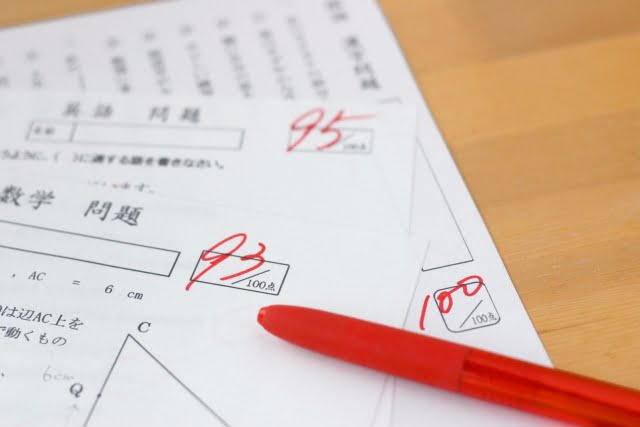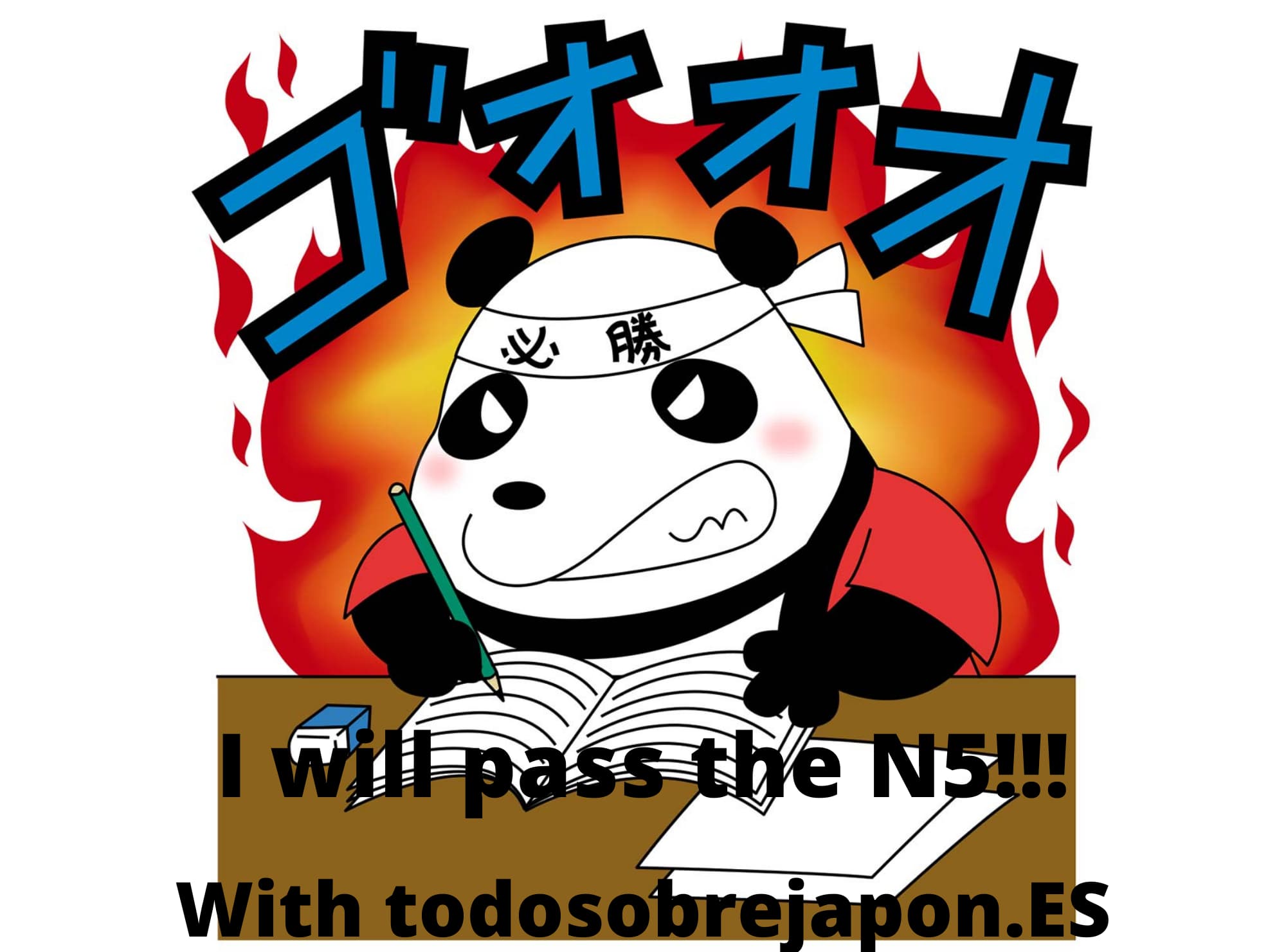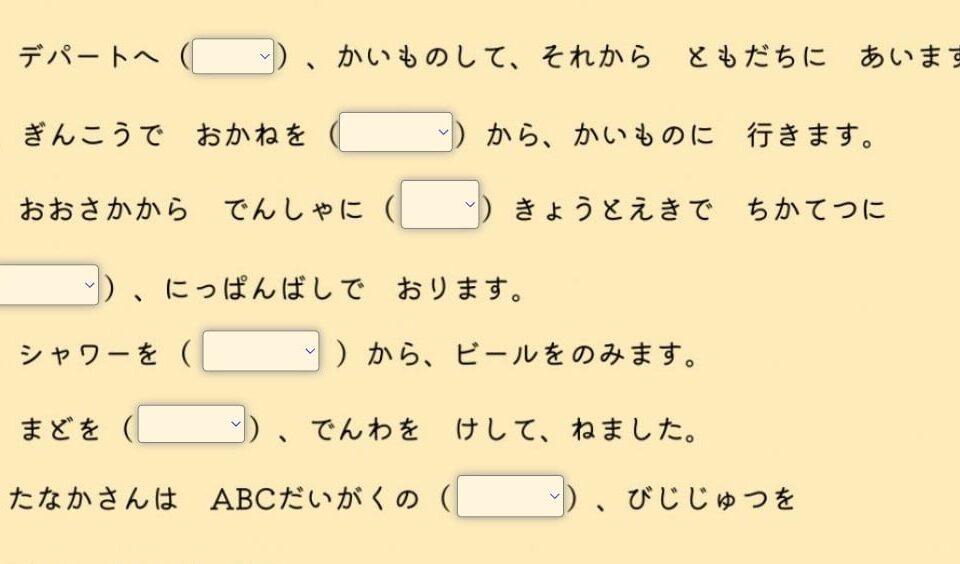Below we show you all about the adjectives jlpt n5.
LIST OF I-ADJECTIVES JLPT N5 TO PASS THE EXAM
This is the table of all the i-adjectives you need to know for the Japanese Language Proficiency Test (JLPT) N5.
| Kanji | Furigana | Romaji | Meaning |
| 青い | あおい | aoi* | blue |
| 赤い | あかい | akai* | red |
| 明るい | あかるい | akarui | bright |
| 温かい | あたたかい | atatakai | warm |
| 新しい | あたらしい | atarashii | new |
| 暑い | あつい | atsui | hot (weather, etc.) |
| 厚い | あつい | atsui | thickness |
| 危ない | あぶない | abunai | dangerous |
| 甘い | あまい | amai | sweet |
| 良い | よい / いい | yoi / ii | good |
| 忙しい | いそがしい | isogashii | busy |
| 痛い | いたい | itai | feel pain/painful |
| 薄い | うすい | usui | thin |
| 美味しい | おいしい | oishii | tasty, delicious |
| 大きい | おおきい | ookii | large |
| 遅い | おそい | osoi | late, slow |
| 重い | おもい | omoi | heavy |
| 面白い | おもしろい | omoshiroi | interesting, fun |
| 辛い | からい | karai | spicy |
| 軽い | かるい | karui | light (not heavy) |
| 可愛い | かわいい | kawaii | nice, pretty |
| 黄色い | きいろい | kiiroi | yellow |
| 汚い | きたない | kitanai | dirty |
| 暗い | くらい | kurai | dark |
| 黒い | くろい | kuroi | black |
| 寒い | さむい | samui | cold |
| 白い | しろい | shiroi | white |
| 涼しい | すずしい | suzushii | cool |
| 狭い | せまい | semai | narrow |
| 高い | たかい | takai | tall, expensive |
| 楽しい | たのしい | tanoshii | enjoyable, fun |
| 小さい | ちいさい | chiisai | small |
| 近い | ちかい | chikai | near |
| 詰らない | つまらない | tsumaranai | uninteresting |
| 冷たい | つめたい | tsumetai | cold |
| 強い | つよい | tsuyoi | strong |
| 遠い | とおい | tooi | far |
| 長い | ながい | nagai | length |
| 早い | はやい | hayai | early |
| 速い | はやい | hayai | fast |
| 低い | ひくい | hikui | low (position) |
| 広い | ひろい | hiroi | wide, spacious |
| 太い | ふとい | futoi | thick, fat |
| 古い | ふるい | furui | ancient, old |
| 欲しい | ほしい | hoshii | want something |
| 細い | ほそい | hosoi | slim, thin |
| 不味い | まずい | mazui | bad taste |
| 丸い | まるい | marui | round |
| 短い | みじかい | mijikai | short |
| 難しい | むずかしい | muzukashii | difficult |
| 寂しい | さびしい | sabishii | lonely |
| 優しい | やさしい | yasashii | kind |
| 安い | やすい | yasui | cheap |
| 若い | わかい | wakai | young |
*REMEMBER: that the basic colors of Japanese are conjugated by adding i. Since red would be aka and red akai. See this post to clarify the doubts: THE COLORS IN JAPANESE AND HOW TO CONJUGATE THEM..
If you want more jlpt n5 vocabulary, click here:
- LIST OF THE 100 KANJI WITH EXERCISES AND MEANING. You will need to keep an eye to understand the examples below, as they will have kanji in them.
- LISTA DE TODOS LOS VERBOS Y CONJUGACIONES
- COMO USAR VERBOS EN JAPONÉS, FORMAS GODAN…
- COMO USAR KANJI Y PRONUNCIACIÓN + LECTURA UNYOMI Y KUNYOMI
- JAPANESE HONORIFICS: SAN, SENPAI, SAMA, KUN, CHAN…AND MORE

i-adjectives: negation – kunai-form (kunai form)
Japanese i adjectives can also express a negative meaning. It is close to adding un- to a Spanish (fácil= un -fácil, no es fácil) or English (easy = un-easy, not easy) adjective. In order to construct this form you first remove the い – I at the end of the simple form and add くない – KUNAI to the i-adjective stem as described in the following examples:
- 高い => 高- => 高 + くない => 高くない
- takai => taka- => taka + kunai => takakunai
| Simple form | Romaji | Meaning | Negation | Romaji | Meaning |
| 高い | takai | tall | 高くない | takakunai | is not tall |
| 安い | yasui | cheap | 安くない | yasukunai | is not cheap |
| 美味しい | oishii | tasty | 美味しくない | oishikunai | is not tasty |
| 広い | hiroi | spacious | 広くない | hirokunai | is not spacious |
| 寂しい | sabishii | lonely | 寂しくない | sabishikunai | is not lonely |
Example of kunai form
| Kanji | 隣りのスーパーはあまり高くないです。 |
| Furigana | となりのスーパーはあまりたかくないです。 |
| Romaji | tonari no suupaa wa amari takakunai desu. |
| English | The neighborhood supermarket is not very expensive. |
i-adjectives: negation of the past – kunakatta-form (how to negate the past in Japanese) kunakatta form
It can also express a negative meaning of an adjective i that happens in the past. In Spanish it is equivalent to “no estaba” and in English this is the equivalent of “was not”. The construction of this form is very similar to the kunai form. You remove the い (i) at the end of the simple form and add くなかった (kunakatta) to the root of the adjective i as described in the following examples:
- 高い => 高- => 高 + くなかった => 高くなかった
- takai => taka- => taka + kunakatta => takakunakatta
| Simple form | Romaji | Meaning | Negation | Romaji | Meaning |
| 高い | takai | tall | 高くなかった | takakunakatta | was not tall |
| 安い | yasui | cheap | 安くなかった | yasukunakatta | was not cheap |
| 美味しい | oishii | tasty | 美味しくなかった | oishikunakatta | was not tasty |
| 広い | hiroi | spacious | 広くなかった | hirokunakatta | was not spacious |
| 寂しい | sabishii | lonely | 寂しくなかった | sabishikunakatta | was not lonely |
Example of kunakatta form
| Kanji | 昨日の授業はあまり面白くなかったです。 |
| Furigana | きのうのじゅぎょうはあまりおもしろくなかったです。 |
| Romaji | kinou no jugyou wa amari omoshirokunakatta desu. |
| English | Yesterday’s lesson was not very interesting. |
i-adjectives: past tense – katta form (katta form)
Japanese i adjectives can also express situations in the past, as we have said. While in English you have many past tense combinations, or in English you have to use “was” in front of the word, i adjectives can build the past tense on their own. By removing the い (i) at the end of the simple form and adding かった (katta) to the root of the i adjective as described in the following examples:
- 高い => 高- => 高 + かった => 高かった
- takai => taka- => taka + katta => takakatta
| Simple form | Romaji | Meaning | Negation | Romaji | Meaning |
| 高い | takai | tall | 高かった | takakatta | was tall |
| 安い | yasui | cheap | 安かった | yasukatta | was cheap |
| 美味しい | oishii | tasty | 美味しかった | oishikatta | was tasty |
| 広い | hiroi | spacious | 広かった | hirokatta | was spacious |
| 寂しい | sabishii | lonely | 寂しかった | sabishikatta | was lonely |
Ejemplo de forma katta
| Kanji | この話はあまり面白かったです。 |
| Furigana | このはなしはあまりおもしろかったです。 |
| Romaji | kono hanashi wa amari omoshirokatta desu. |
| English | This story was very interesting. |
i-adjectives: sa-form (sa-form) how to change from adjective to noun in Japanese
The Japanese language is very flexible with adjectives. The sa-form, or -sa form, allows you to use an adjective i as a noun or in other words to add ~osa ~or ~ness (e.g., useful => usefulness, powerful => powerful, etc.).
It is very easy to construct. Simply replace “i” at the end of the word with a “sa”. So 楽しい (tanoshii, nice) becomes joy as 楽しさ (tanoshisa). Here are some more examples to make it clear:
| Simple form | Romaji | Meaning | sa Form | Romaji | Meaning |
| 楽しい | tanoshii | enjoyable | 楽しさ | tanoshisa | joy |
| 美しい | utsukushii | beautiful | 美しさ | utsukushisa | beauty |
| 新しい | atarashii | new | 新しさ | atarashisa | novelty |
| 赤い | akai | red | 赤さ | akasa | redness |
| 大きい | ookii | big | 大きさ | ookisa | size, dimensions |
Example of SA form
| Kanji | 日本のお寺の美しさが好きです。。 |
| Furigana | にほんのはなしはあまりおもしろかったです。 |
| Romaji | Ni hon’no hanashi wa amari omoshirokattadesu. |
| English | I like the beauty of Japanese temples. |
i-adjectives: sou-form (forma sou)
The sou form of an adjective i expresses that something appears to be a certain way. It is translated in phrases like: that looks red (akasou).
It is very easy to construct. Simply replace the last “i” of the adjective with a “sou”. So 楽しい (tanoshii, nice) becomes 楽しそう (tanoshisou) looks funny. Here are some more examples to make it clear:
| Simple form | Romaji | Meaning | sa Form | Romaji | Meaning |
| 楽しい | tanoshii | enjoyable | 楽しそう | tanoshisou | Looks enjoyable |
| 美しい | utsukushii | beautiful | 美しそう | utsukushisou | Looks beautiful |
| 新しい | atarashii | new | 新しそう | atarashisou | Looks new |
| 赤い | akai | red | 赤そう | akasou | Looks red |
| 大きい | ookii | big | 大きそう | ookisou | Looks big |
Example of SOU form
| Kanji | この料理はとても美味しそうです。 |
| Furigana | このりょうりはとてもおいしそうです。 |
| Romaji | kono ryouri wa totemo oishisou desu. |
| English | This dish looks very delicious. |
IN THE NEXT ARTICLE WE WILL SEE -NA ADJECTIVES FOR JLPT N5
DIFFERENCE BETWEEN い I ADJECTIVES AND な NA ADJECTIVES IN JAPANESE
As a general rule: Adjectives i い always end in い (i), but adjectives な (na) even if they end in い (i) is not out of its kanji (such as okurigana).
美しい (しい is the okurigana)
うつく
綺麗な
きれい ( although it ends in i this is part of the kanji)
*This is not always the case, but this is a general rule.
TO KNOW MORE ABOUT NA ADJECTIVES IN JAPANESE READ THIS..
SELF-CORRECTING INTERACTIVE EXERCISES ON I-ADJECTIVES JLPT N5 IN JAPANESE
Here you will find many exercises to reinforce what you have learned, we hope you like it. Leave a comment.






